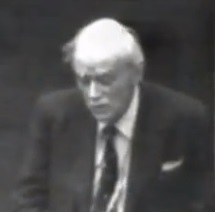|
Spinning Bloch Spheres
Larmor Frequency
Rabi Oscillations
Qantum Spin States
Protons and Neutrons
Electrons

Dirac himself discussing the history of quantum mechanics and source of his discovery of the "Dirac Equation".
He shows how the Poisson Bracket matches his commutators and expands on the Klien-Gordon equation for spin.
Click for video feed
Summary
|
Electrons as coupled 2-spinors
|

| |
These coupled spinors spin, at the speed of light, orthogonal to themselves. From the direction of spin,
you can see there is no way to push the electron and anti-electron together without destroying them.
Also note, turning the inner (blue) loop 360 degrees, only turns the larger
(red) loop 180 degrees leaving it upside down. You must turn another 360 degrees (720 total) before it is right side up.
|
|
Spin and Bra-ket notation
From Townsend's "A Modern Approach to Quantum Mechanics", understanding spin and bra-ket notation.
Derivation of the "Dirac Equation"
Consider the Klien-Gordon equation (in c=hbar = 1 units)
You get this equation by starting with the relativistic invariant and replacing E with the energy operator
and p with the momentum operator. Because this is second order, you can't reproduce the result that probability
is conserved like with the Schrodinger equation (it won't hold it's normalization). So Dirac set out to find a
first order equation, which would "square" to the Klien-Gordon equation, so that it would both be relativistic
and preserve probability.
To state the problem mathematically, you have some operator D, such that:
Dψ=0 and D²ψ=(∂²+m²)ψ=0
- Write down a first order operator for D, and solve for coefficients:
D=(A∂−Bm), D²=(A∂−Bm)(A∂−Bm)=A²∂²+m²B²−(AB+BA)m∂=∂²+m²
- So A² and B² have to be one, but that doesn't allow AB + BA to be zero, as long as A and B are complex numbers.
Dirac's great idea is that A and B can be matrices, and by finding a set of matrices with those properties you have
derived the Dirac Equation.
That is the derivation, and how it's linked to special relativity (being closely related to the
Klien-Gordon equation). Anti-matter can also be predicted from solutions of the Dirac equation.
Derivation of the "Dirac Electron"
Dirac's one equation for a massive particle can be rewritten as two equations for two
interacting massless particles, where the coupling constant of the interaction is the mass
of the electron.
From Penrose's Road to Reality (Chapter 25, Section 2):
- It turns out that the Dirac spinor ψ, with its 4 complex components, can be represented,
as a pair of 2-spinors αA and βA', one with an unprimed index and one with a primed
index: ψ = (αA, βA')
The Dirac equation can then be written as an equation coupling these two
2-spinors, each acting as a kind of ‘source’ for the other, with a ‘coupling
constant’ M describing the strength of the ‘interaction’ between the two...
- More formally, break an electron field into two parts (left and right) as ψ=ψL+ψR
where ψL=(1/2)*(1−γ5)ψ and ψR=(1/2)*(1+γ5)ψ.
These two massless fields, one left-handed and one right-handed, interact with coupling constant M
equal to the mass of the electron.
|
Learn more...
|
|



